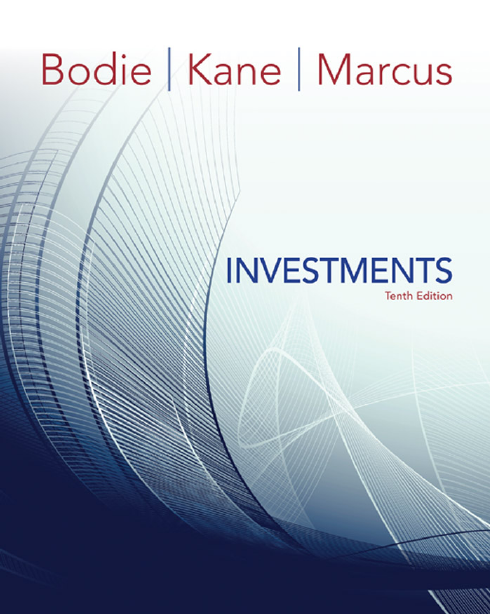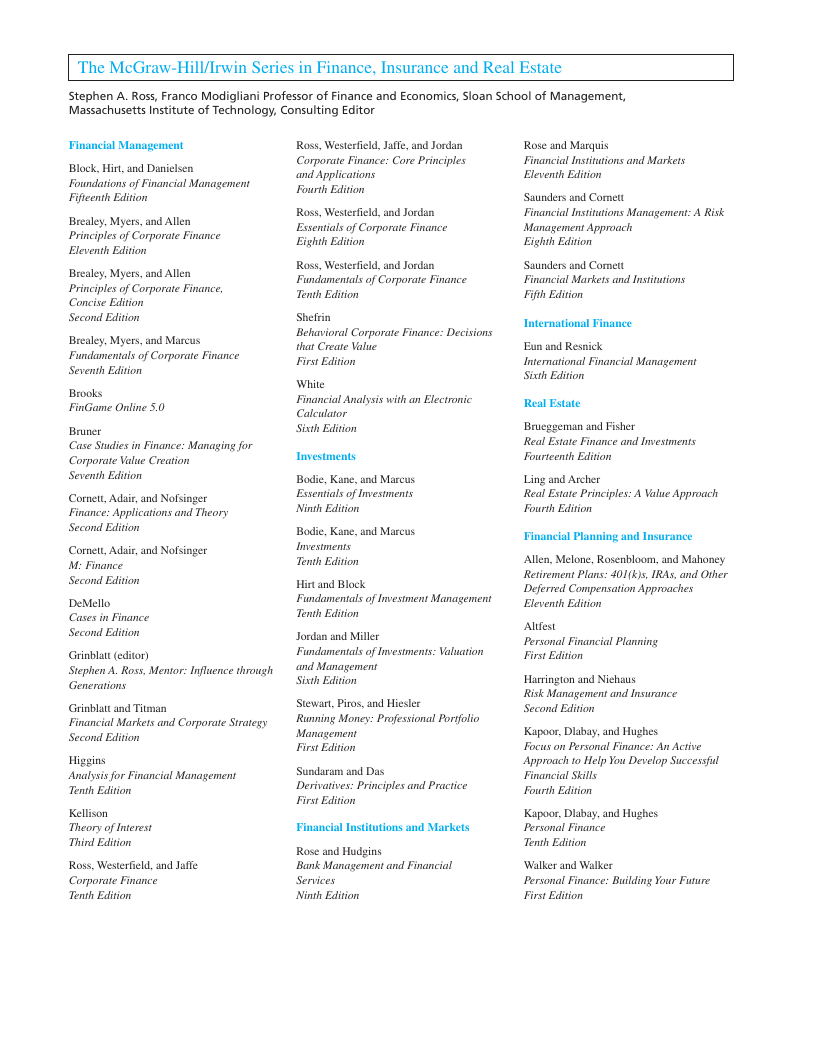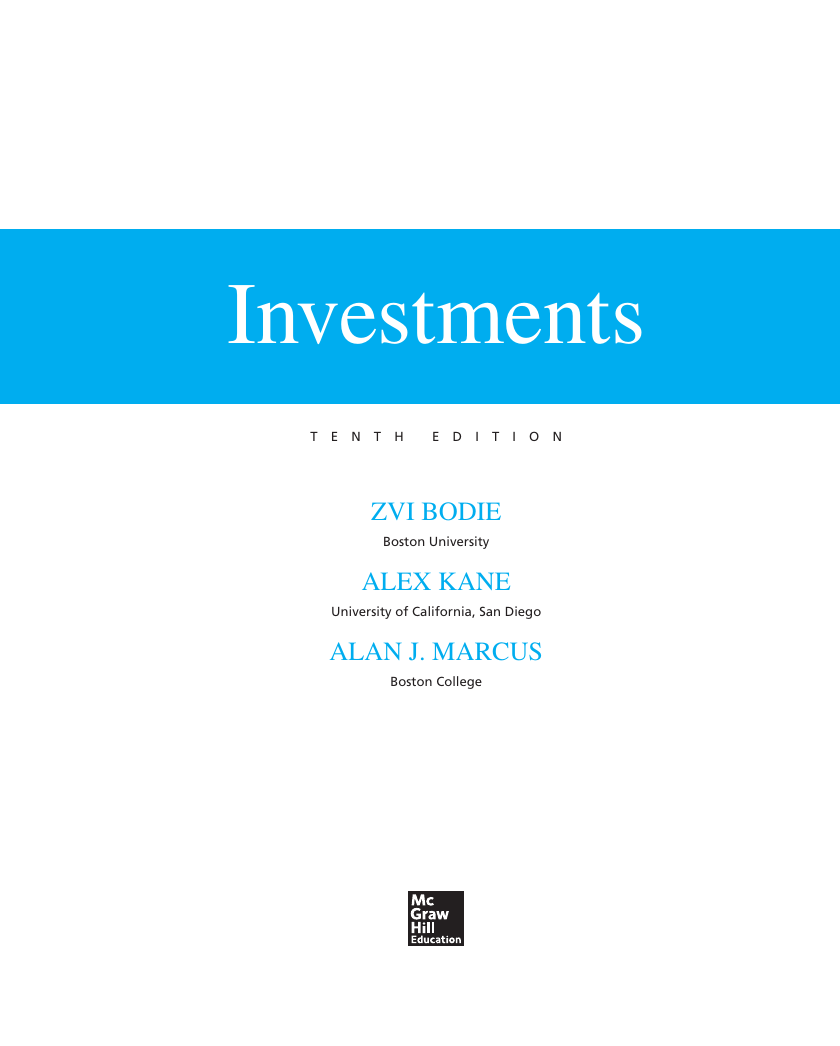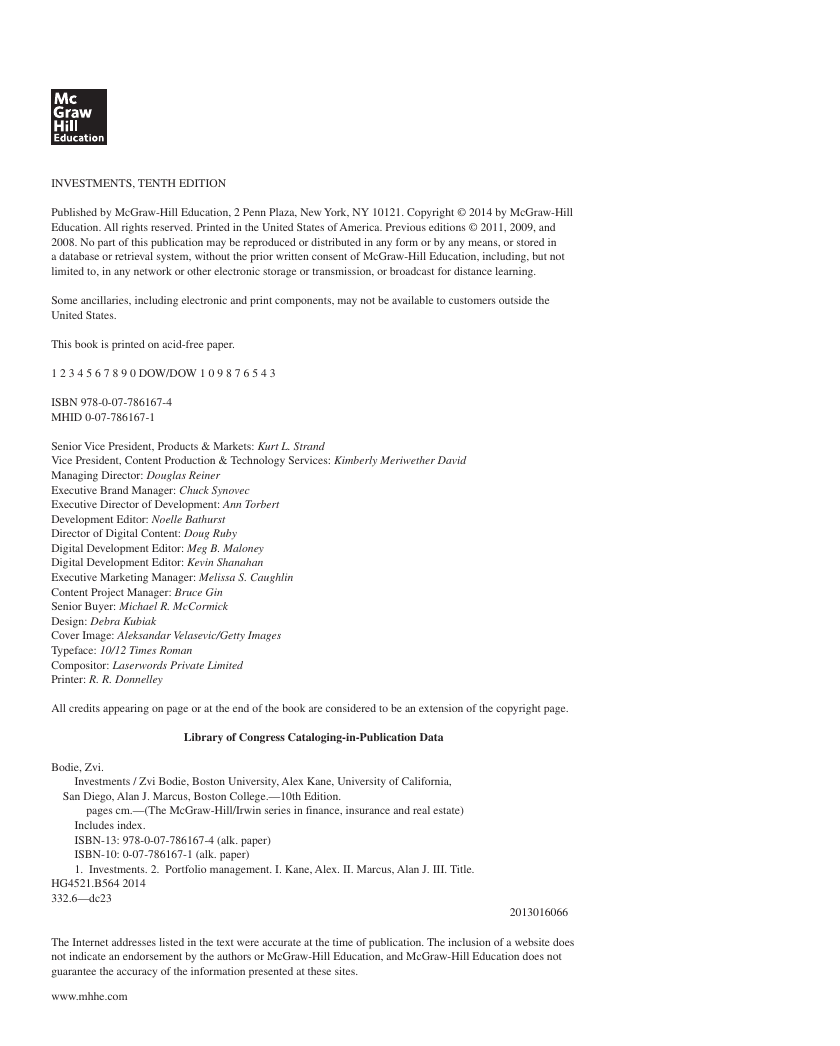Cover
Title
Copyright
Contents
Preface
PART I: Introduction
CHAPTER 1 The Investment Environment
1.1 Real Assets versus Financial Assets
1.2 Financial Assets
1.3 Financial Markets and the Economy
The Informational Role of Financial Markets
Consumption Timing
Allocation of Risk
Separation of Ownership and Management
Corporate Governance and Corporate Ethics
1.4 The Investment Process
1.5 Markets Are Competitive
The Risk–Return Trade-Off
Efficient Markets
1.6 The Players
Financial Intermediaries
Investment Bankers
Venture Capital and Private Equity
1.7 The Financial Crisis of 2008
Antecedents of the Crisis
Changes in Housing Finance
Mortgage Derivatives
Credit Default Swaps
The Rise of Systemic Risk
The Shoe Drops
The Dodd-Frank Reform Act
1.8 Outline of the Text
End of Chapter Material
CHAPTER 2 Asset Classes and Financial Instruments
2.1 The Money Market
Treasury Bills
Certificates of Deposit
Commercial Paper
Bankers' Acceptances
Eurodollars
Repos and Reverses
Federal Funds
Brokers' Calls
The LIBOR Market
Yields on Money Market Instruments
2.2 The Bond Market
Treasury Notes and Bonds
Inflation-Protected Treasury Bonds
Federal Agency Debt
International Bonds
Municipal Bonds
Corporate Bonds
Mortgages and Mortgage-Backed Securities
2.3 Equity Securities
Common Stock as Ownership Shares
Characteristics of Common Stock
Stock Market Listings
Preferred Stock
Depository Receipts
2.4 Stock and Bond Market Indexes
Stock Market Indexes
Dow Jones Averages
Standard & Poor's Indexes
Other U. S. Market-Value Indexes
Equally Weighted Indexes
Foreign and International Stock Market Indexes
Bond Market Indicators
2.5 Derivative Markets
Options
Futures Contracts
End of Chapter Material
CHAPTER 3 How Securities Are Traded
3.1 How Firms Issue Securities
Privately Held Firms
Publicly Traded Companies
Shelf Registration
Initial Public Offerings
3.2 How Securities Are Traded
Types of Markets
Direct Search Markets
Brokered Markets
Dealer Markets
Auction Markets
Types of Orders
Market Orders
Price-Contingent Orders
Trading Mechanisms
Dealer Markets
Electronic Communication Networks (ECNs)
Specialist Markets
3.3 The Rise of Electronic Trading
3.4 U. S. Markets
NASDAQ
The New York Stock Exchange
ECNs
3.5 New Trading Strategies
Algorithmic Trading
High-Frequency Trading
Dark Pools
Bond Trading
3.6 Globalization of Stock Markets
3.7 Trading Costs
3.8 Buying on Margin
3.9 Short Sales
3.10 Regulation of Securities Markets
Self-Regulation
The Sarbanes-Oxley Act
Insider Trading
End of Chapter Material
CHAPTER 4 Mutual Funds and Other Investment Companies
4.1 Investment Companies
4.2 Types of Investment Companies
Unit Investment Trusts
Managed Investment Companies
Other Investment Organizations
Commingled Funds
Real Estate Investment Trusts (REITs)
Hedge Funds
4.3 Mutual Funds
Investment Policies
Money Market Funds
Equity Funds
Sector Funds
Bond Funds
International Funds
Balanced Funds
Asset Allocation and Flexible Funds
Index Funds
How Funds Are Sold
4.4 Costs of Investing in Mutual Funds
Fee Structure
Operating Expenses
Front-End Load
Back-End Load
12b-1 Charges
Fees and Mutual Fund Returns
4.5 Taxation of Mutual Fund Income
4.6 Exchange-Traded Funds
4.7 Mutual Fund Investment Performance: A First Look
4.8 Information on Mutual Funds
End of Chapter Material
PART II: Portfolio Theory and Practice
CHAPTER 5 Risk, Return, and the Historical Record
5.1 Determinants of the Level of Interest Rates
Real and Nominal Rates of Interest
The Equilibrium Real Rate of Interest
The Equilibrium Nominal Rate of Interest
Taxes and the Real Rate of Interest
5.2 Comparing Rates of Return for Different Holding Periods
Annual Percentage Rates
Continuous Compounding
5.3 Bills and Inflation, 1926–2012
5.4 Risk and Risk Premiums
Holding-Period Returns
Expected Return and Standard Deviation
Excess Returns and Risk Premiums
5.5 Time Series Analysis of Past Rates of Return
Time Series versus Scenario Analysis
Expected Returns and the Arithmetic Average
The Geometric (Time-Weighted) Average Return
Variance and Standard Deviation
Mean and Standard Deviation Estimates from Higher-Frequency Observations
The Reward-to-Volatility (Sharpe) Ratio
5.6 The Normal Distribution
5.7 Deviations from Normality and Risk Measures
Value at Risk
Expected Shortfall
Lower Partial Standard Deviation and the Sortino Ratio
Relative Frequency of Large, Negative 3-Sigma Returns
5.8 Historic Returns on Risky Portfolios
Portfolio Returns
A Global View of the Historical Record
5.9 Long-Term Investments
Normal and Lognormal Returns
Simulation of Long-Term Future Rates of Return
The Risk-Free Rate Revisited
Where Is Research on Rates of Return Headed?
Forecasts for the Long Haul
End of Chapter Material
CHAPTER 6 Capital Allocation to Risky Assets
6.1 Risk and Risk Aversion
Risk, Speculation, and Gambling
Risk Aversion and Utility Values
Estimating Risk Aversion
6.2 Capital Allocation across Risky and Risk-Free Portfolios
6.3 The Risk-Free Asset
6.4 Portfolios of One Risky Asset and a Risk-Free Asset
6.5 Risk Tolerance and Asset Allocation
Nonnormal Returns
6.6 Passive Strategies: The Capital Market Line
End of Chapter Material
Appendix A: Risk Aversion, Expected Utility, and the St. Petersburg Paradox
Appendix B: Utility Functions and Equilibrium Prices of Insurance Contracts
Appendix C: The Kelly Criterion
CHAPTER 7 Optimal Risky Portfolios
7.1 Diversification and Portfolio Risk
7.2 Portfolios of Two Risky Assets
7.3 Asset Allocation with Stocks, Bonds, and Bills
Asset Allocation with Two Risky Asset Classes
7.4 The Markowitz Portfolio Optimization Model
Security Selection
Capital Allocation and the Separation Property
The Power of Diversification
Asset Allocation and Security Selection
Optimal Portfolios and Nonnormal Returns
7.5 Risk Pooling, Risk Sharing, and the Risk of Long-Term Investments
Risk Pooling and the Insurance Principle
Risk Sharing
Investment for the Long Run
End of Chapter Material
Appendix A: A Spreadsheet Model for Efficient Diversification
Appendix B: Review of Portfolio Statistics
CHAPTER 8 Index Models
8.1 A Single-Factor Security Market
The Input List of the Markowitz Model
Normality of Returns and Systematic Risk
8.2 The Single-Index Model
The Regression Equation of the Single-Index Model
The Expected Return–Beta Relationship
Risk and Covariance in the Single-Index Model
The Set of Estimates Needed for the Single-Index Model
The Index Model and Diversification
8.3 Estimating the Single-Index Model
The Security Characteristic Line for Hewlett-Packard
The Explanatory Power of the SCL for HP
Analysis of Variance
The Estimate of Alpha
The Estimate of Beta
Firm-Specific Risk
Correlation and Covariance Matrix
8.4 Portfolio Construction and the Single-Index Model
Alpha and Security Analysis
The Index Portfolio as an Investment Asset
The Single-Index-Model Input List
The Optimal Risky Portfolio in the Single-Index Model
The Information Ratio
Summary of Optimization Procedure
An Example
Risk Premium Forecasts
The Optimal Risky Portfolio
8.5 Practical Aspects of Portfolio Management with the Index Model
Is the Index Model Inferior to the Full-Covariance Model?
The Industry Version of the Index Model
Predicting Betas
Index Models and Tracking Portfolios
End of Chapter Material
PART III: Equilibrium in Capital Markets
CHAPTER 9 The Capital Asset Pricing Model
9.1 The Capital Asset Pricing Model
Why Do All Investors Hold the Market Portfolio?
The Passive Strategy Is Efficient
The Risk Premium of the Market Portfolio
Expected Returns on Individual Securities
The Security Market Line
The CAPM and the Single-Index Market
9.2 Assumptions and Extensions of the CAPM
Assumptions of the CAPM
Challenges and Extensions to the CAPM
The Zero-Beta Model
Labor Income and Nontraded Assets
A Multiperiod Model and Hedge Portfolios
A Consumption-Based CAPM
Liquidity and the CAPM
9.3 The CAPM and the Academic World
9.4 The CAPM and the Investment Industry
End of Chapter Material
CHAPTER 10 Arbitrage Pricing Theory and Multifactor Models of Risk and Return
10.1 Multifactor Models: An Overview
Factor Models of Security Returns
10.2 Arbitrage Pricing Theory
Arbitrage, Risk Arbitrage, and Equilibrium
Well-Diversified Portfolios
Diversification and Residual Risk in Practice
Executing Arbitrage
The No-Arbitrage Equation of the APT
10.3 The APT, the CAPM, and the Index Model
The APT and the CAPM
The APT and Portfolio Optimization in a Single-Index Market
10.4 A Multifactor APT
10.5 The Fama-French (FF) Three-Factor Model
End of Chapter Material
CHAPTER 11 The Efficient Market Hypothesis
11.1 Random Walks and the Efficient Market Hypothesis
Competition as the Source of Efficiency
Versions of the Efficient Market Hypothesis
11.2 Implications of the EMH
Technical Analysis
Fundamental Analysis
Active versus Passive Portfolio Management
The Role of Portfolio Management in an Efficient Market
Resource Allocation
11.3 Event Studies
11.4 Are Markets Efficient?
The Issues
The Magnitude Issue
The Selection Bias Issue
The Lucky Event Issue
Weak-Form Tests: Patterns in Stock Returns
Returns over Short Horizons
Returns over Long Horizons
Predictors of Broad Market Returns
Semistrong Tests: Market Anomalies
The Small-Firm-in-January Effect
The Neglected-Firm Effect and Liquidity Effects
Book-to-Market Ratios
Post–Earnings-Announcement Price Drift
Strong-Form Tests: Inside Information
Interpreting the Anomalies
Risk Premiums or Inefficiencies?
Anomalies or Data Mining?
Anomalies over Time
Bubbles and Market Efficiency
11.5 Mutual Fund and Analyst Performance
Stock Market Analysts
Mutual Fund Managers
So, Are Markets Efficient?
End of Chapter Material
CHAPTER 12 Behavioral Finance and Technical Analysis
12.1 The Behavioral Critique
Information Processing
Forecasting Errors
Overconfidence
Conservatism
Behavioral Biases
Framing
Mental Accounting
Regret Avoidance
Affect
Prospect Theory
Limits to Arbitrage
Fundamental Risk
Implementation Costs
Model Risk
Limits to Arbitrage and the Law of One Price
"Siamese Twin" Companies
Equity Carve-Outs
Closed-End Funds
Bubbles and Behavioral Economics
Evaluating the Behavioral Critique
12.2 Technical Analysis and Behavioral Finance
Trends and Corrections
Momentum and Moving Averages
Relative Strength
Breadth
Sentiment Indicators
Trin Statistic
Confidence Index
Put/Call Ratio
A Warning
End of Chapter Material
CHAPTER 13 Empirical Evidence on Security Returns
13.1 The Index Model and the Single-Factor APT
The Expected Return–Beta Relationship
Setting Up the Sample Data
Estimating the SCL
Estimating the SML
Tests of the CAPM
The Market Index
Measurement Error in Beta
13.2 Tests of the Multifactor CAPM and APT
Labor Income
Private (Nontraded) Business
Early Versions of the Multifactor CAPM and APT
A Macro Factor Model
13.3 Fama-French-Type Factor Models
Size and B/M as Risk Factors
Behavioral Explanations
Momentum: A Fourth Factor
13.4 Liquidity and Asset Pricing
13.5 Consumption-Based Asset Pricing and the Equity Premium Puzzle
Consumption Growth and Market Rates of Return
Expected versus Realized Returns
Survivorship Bias
Extensions to the CAPM May Resolve the Equity Premium Puzzle
Liquidity and the Equity Premium Puzzle
Behavioral Explanations of the Equity Premium Puzzle
End of Chapter Material
PART IV: Fixed-Income Securities
CHAPTER 14 Bond Prices and Yields
14.1 Bond Characteristics
Treasury Bonds and Notes
Accrued Interest and Quoted Bond Prices
Corporate Bonds
Call Provisions on Corporate Bonds
Convertible Bonds
Puttable Bonds
Floating-Rate Bonds
Preferred Stock
Other Domestic Issuers
International Bonds
Innovation in the Bond Market
Inverse Floaters
Asset-Backed Bonds
Catastrophe Bonds
Indexed Bonds
14.2 Bond Pricing
Bond Pricing between Coupon Dates
14.3 Bond Yields
Yield to Maturity
Yield to Call
Realized Compound Return versus Yield to Maturity
14.4 Bond Prices over Time
Yield to Maturity versus Holding-Period Return
Zero-Coupon Bonds and Treasury Strips
After-Tax Returns
14.5 Default Risk and Bond Pricing
Junk Bonds
Determinants of Bond Safety
Bond Indentures
Sinking Funds
Subordination of Further Debt
Dividend Restrictions
Collateral
Yield to Maturity and Default Risk
Credit Default Swaps
Credit Risk and Collateralized Debt Obligations
End of Chapter Material
CHAPTER 15 The Term Structure of Interest Rates
15.1 The Yield Curve
Bond Pricing
15.2 The Yield Curve and Future Interest Rates
The Yield Curve under Certainty
Holding-Period Returns
Forward Rates
15.3 Interest Rate Uncertainty and Forward Rates
15.4 Theories of the Term Structure
The Expectations Hypothesis
Liquidity Preference
15.5 Interpreting the Term Structure
15.6 Forward Rates as Forward Contracts
End of Chapter Material
CHAPTER 16 Managing Bond Portfolios
16.1 Interest Rate Risk
Interest Rate Sensitivity
Duration
What Determines Duration?
Rule 1 for Duration
Rule 2 for Duration
Rule 3 for Duration
Rule 4 for Duration
Rule 5 for Duration
16.2 Convexity
Why Do Investors Like Convexity?
Duration and Convexity of Callable Bonds
Duration and Convexity of Mortgage-Backed Securities
16.3 Passive Bond Management
Bond-Index Funds
Immunization
Cash Flow Matching and Dedication
Other Problems with Conventional Immunization
16.4 Active Bond Management
Sources of Potential Profit
Horizon Analysis
End of Chapter Material
PART V: Security Analysis
CHAPTER 17 Macroeconomic and Industry Analysis
17.1 The Global Economy
17.2 The Domestic Macroeconomy
17.3 Demand and Supply Shocks
17.4 Federal Government Policy
Fiscal Policy
Monetary Policy
Supply-Side Policies
17.5 Business Cycles
The Business Cycle
Economic Indicators
Other Indicators
17.6 Industry Analysis
Defining an Industry
Sensitivity to the Business Cycle
Sector Rotation
Industry Life Cycles
Start-Up Stage
Consolidation Stage
Maturity Stage
Relative Decline
Industry Structure and Performance
Threat of Entry
Rivalry between Existing Competitors
Pressure from Substitute Products
Bargaining Power of Buyers
Bargaining Power of Suppliers
End of Chapter Material
CHAPTER 18 Equity Valuation Models
18.1 Valuation by Comparables
Limitations of Book Value
18.2 Intrinsic Value versus Market Price
18.3 Dividend Discount Models
The Constant-Growth DDM
Convergence of Price to Intrinsic Value
Stock Prices and Investment Opportunities
Life Cycles and Multistage Growth Models
Multistage Growth Models
18.4 Price–Earnings Ratio
The Price–Earnings Ratio and Growth Opportunities
P/E Ratios and Stock Risk
Pitfalls in P/E Analysis
Combining P/E Analysis and the DDM
Other Comparative Valuation Ratios
Price-to-Book Ratio
Price-to-Cash-Flow Ratio
Price-to-Sales Ratio
18.5 Free Cash Flow Valuation Approaches
Comparing the Valuation Models
The Problem with DCF Models
18.6 The Aggregate Stock Market
End of Chapter Material
CHAPTER 19 Financial Statement Analysis
19.1 The Major Financial Statements
The Income Statement
The Balance Sheet
The Statement of Cash Flows
19.2 Measuring Firm Performance
19.3 Profitability Measures
Return on Assets, ROA
Return on Capital, ROC
Return on Equity, ROE
Financial Leverage and ROE
Economic Value Added
19.4 Ratio Analysis
Decomposition of ROE
Turnover and Other Asset Utilization Ratios
Liquidity Ratios
Market Price Ratios: Growth versus Value
Choosing a Benchmark
19.5 An Illustration of Financial Statement Analysis
19.6 Comparability Problems
Inventory Valuation
Depreciation
Inflation and Interest Expense
Fair Value Accounting
Quality of Earnings and Accounting Practices
International Accounting Conventions
19.7 Value Investing: The Graham Technique
End of Chapter Material
PART VI: Options, Futures, and Other Derivatives
CHAPTER 20 Options Markets: Introduction
20.1 The Option Contract
Options Trading
American and European Options
Adjustments in Option Contract Terms
The Options Clearing Corporation
Other Listed Options
Index Options
Futures Options
Foreign Currency Options
Interest Rate Options
20.2 Values of Options at Expiration
Call Options
Put Options
Option versus Stock Investments
20.3 Option Strategies
Protective Put
Covered Calls
Straddle
Spreads
Collars
20.4 The Put-Call Parity Relationship
20.5 Option-Like Securities
Callable Bonds
Convertible Securities
Warrants
Collateralized Loans
Levered Equity and Risky Debt
20.6 Financial Engineering
20.7 Exotic Options
Asian Options
Barrier Options
Lookback Options
Currency-Translated Options
Digital Options
End of Chapter Material
CHAPTER 21 Option Valuation
21.1 Option Valuation: Introduction
Intrinsic and Time Values
Determinants of Option Values
21.2 Restrictions on Option Values
Restrictions on the Value of a Call Option
Early Exercise and Dividends
Early Exercise of American Puts
21.3 Binomial Option Pricing
Two-State Option Pricing
Generalizing the Two-State Approach
Making the Valuation Model Practical
21.4 Black-Scholes Option Valuation
The Black-Scholes Formula
Dividends and Call Option Valuation
Put Option Valuation
Dividends and Put Option Valuation
21.5 Using the Black-Scholes Formula
Hedge Ratios and the Black-Scholes Formula
Portfolio Insurance
Option Pricing and the Crisis of 2008–2009
Option Pricing and Portfolio Theory
Hedging Bets on Mispriced Options
21.6 Empirical Evidence on Option Pricing
End of Chapter Material
CHAPTER 22 Futures Markets
22.1 The Futures Contract
The Basics of Futures Contracts
Existing Contracts
22.2 Trading Mechanics
The Clearinghouse and Open Interest
The Margin Account and Marking to Market
Cash versus Actual Delivery
Regulations
Taxation
22.3 Futures Markets Strategies
Hedging and Speculation
Basis Risk and Hedging
22.4 Futures Prices
The Spot-Futures Parity Theorem
Spreads
Forward versus Futures Pricing
22.5 Futures Prices versus Expected Spot Prices
Expectations Hypothesis
Normal Backwardation
Contango
Modern Portfolio Theory
End of Chapter Material
CHAPTER 23 Futures, Swaps, and Risk Management
23.1 Foreign Exchange Futures
The Markets
Interest Rate Parity
Direct versus Indirect Quotes
Using Futures to Manage Exchange Rate Risk
23.2 Stock-Index Futures
The Contracts
Creating Synthetic Stock Positions: An Asset Allocation Tool
Index Arbitrage
Using Index Futures to Hedge Market Risk
23.3 Interest Rate Futures
Hedging Interest Rate Risk
23.4 Swaps
Swaps and Balance Sheet Restructuring
The Swap Dealer
Other Interest Rate Contracts
Swap Pricing
Credit Risk in the Swap Market
Credit Default Swaps
23.5 Commodity Futures Pricing
Pricing with Storage Costs
Discounted Cash Flow Analysis for Commodity Futures
End of Chapter Material
PART VII: Applied Portfolio Management
CHAPTER 24 Portfolio Performance Evaluation
24.1 The Conventional Theory of Performance Evaluation
Average Rates of Return
Time-Weighted Returns versus Dollar-Weighted Returns
Dollar-Weighted Return and Investment Performance
Adjusting Returns for Risk
The M[sup(2)] Measure of Performance
Sharpe's Ratio Is the Criterion for Overall Portfolios
Appropriate Performance Measures in Two Scenarios
Jane's Portfolio Represents Her Entire Risky Investment Fund
Jane's Choice Portfolio Is One of Many Portfolios Combined into a Large Investment Fund
The Role of Alpha in Performance Measures
Actual Performance Measurement: An Example
Performance Manipulation and the Morningstar Risk-Adjusted Rating
Realized Returns versus Expected Returns
24.2 Performance Measurement for Hedge Funds
24.3 Performance Measurement with Changing Portfolio Composition
24.4 Market Timing
The Potential Value of Market Timing
Valuing Market Timing as a Call Option
The Value of Imperfect Forecasting
24.5 Style Analysis
Style Analysis and Multifactor Benchmarks
Style Analysis in Excel
24.6 Performance Attribution Procedures
Asset Allocation Decisions
Sector and Security Selection Decisions
Summing Up Component Contributions
End of Chapter Material
CHAPTER 25 International Diversification
25.1 Global Markets for Equities
Developed Countries
Emerging Markets
Market Capitalization and GDP
Home-Country Bias
25.2 Risk Factors in International Investing
Exchange Rate Risk
Political Risk
25.3 International Investing: Risk, Return, and Benefits from Diversification
Risk and Return: Summary Statistics
Are Investments in Emerging Markets Riskier?
Are Average Returns Higher in Emerging Markets?
Is Exchange Rate Risk Important in International Portfolios?
Benefits from International Diversification
Misleading Representation of Diversification Benefits
Realistic Benefits from International Diversification
Are Benefits from International Diversification Preserved in Bear Markets?
25.4 Assessing the Potential of International Diversification
25.5 International Investing and Performance Attribution
Constructing a Benchmark Portfolio of Foreign Assets
Performance Attribution
End of Chapter Material
CHAPTER 26 Hedge Funds
26.1 Hedge Funds versus Mutual Funds
26.2 Hedge Fund Strategies
Directional and Nondirectional Strategies
Statistical Arbitrage
26.3 Portable Alpha
An Example of a Pure Play
26.4 Style Analysis for Hedge Funds
26.5 Performance Measurement for Hedge Funds
Liquidity and Hedge Fund Performance
Hedge Fund Performance and Survivorship Bias
Hedge Fund Performance and Changing Factor Loadings
Tail Events and Hedge Fund Performance
26.6 Fee Structure in Hedge Funds
End of Chapter Material
CHAPTER 27 The Theory of Active Portfolio Management
27.1 Optimal Portfolios and Alpha Values
Forecasts of Alpha Values and Extreme Portfolio Weights
Restriction of Benchmark Risk
27.2 The Treynor-Black Model and Forecast Precision
Adjusting Forecasts for the Precision of Alpha
Distribution of Alpha Values
Organizational Structure and Performance
27.3 The Black-Litterman Model
Black-Litterman Asset Allocation Decision
Step 1: The Covariance Matrix from Historical Data
Step 2: Determination of a Baseline Forecast
Step 3: Integrating the Manager's Private Views
Step 4: Revised (Posterior) Expectations
Step 5: Portfolio Optimization
27.4 Treynor-Black versus Black-Litterman: Complements, Not Substitutes
The BL Model as Icing on the TB Cake
Why Not Replace the Entire TB Cake with the BL Icing?
27.5 The Value of Active Management
A Model for the Estimation of Potential Fees
Results from the Distribution of Actual Information Ratios
Results from Distribution of Actual Forecasts
Results with Reasonable Forecasting Records
27.6 Concluding Remarks on Active Management
End of Chapter Material
Appendix A: Forecasts and Realizations of Alpha
Appendix B: The General Black-Litterman Model
CHAPTER 28 Investment Policy and the Framework of the CFA Institute
28.1 The Investment Management Process
Objectives
Individual Investors
Personal Trusts
Mutual Funds
Pension Funds
Endowment Funds
Life Insurance Companies
Non–Life Insurance Companies
Banks
28.2 Constraints
Liquidity
Investment Horizon
Regulations
Tax Considerations
Unique Needs
28.3 Policy Statements
Sample Policy Statements for Individual Investors
28.4 Asset Allocation
Taxes and Asset Allocation
28.5 Managing Portfolios of Individual Investors
Human Capital and Insurance
Investment in Residence
Saving for Retirement and the Assumption of Risk
Retirement Planning Models
Manage Your Own Portfolio or Rely on Others?
Tax Sheltering
The Tax-Deferral Option
Tax-Deferred Retirement Plans
Deferred Annuities
Variable and Universal Life Insurance
28.6 Pension Funds
Defined Contribution Plans
Defined Benefit Plans
Pension Investment Strategies
Investing in Equities
Wrong Reasons to Invest in Equities
28.7 Investments for the Long Run
Target Investing and the Term Structure of Bonds
Making Simple Investment Choices
Inflation Risk and Long-Term Investors
End of Chapter Material
REFERENCES TO CFA PROBLEMS
GLOSSARY
A
B
C
D
E
F
G
H
I
J
K
L
M
N
O
P
Q
R
S
T
U
V
W
Y
Z
NAME INDEX
A
B
C
D
E
F
G
H
I
J
K
L
M
N
O
P
R
S
T
V
W
Y
Z
SUBJECT INDEX
A
B
C
D
E
F
G
H
I
J
K
L
M
N
O
P
Q
R
S
T
U
V
W
Y
Z
















 2023年江西萍乡中考道德与法治真题及答案.doc
2023年江西萍乡中考道德与法治真题及答案.doc 2012年重庆南川中考生物真题及答案.doc
2012年重庆南川中考生物真题及答案.doc 2013年江西师范大学地理学综合及文艺理论基础考研真题.doc
2013年江西师范大学地理学综合及文艺理论基础考研真题.doc 2020年四川甘孜小升初语文真题及答案I卷.doc
2020年四川甘孜小升初语文真题及答案I卷.doc 2020年注册岩土工程师专业基础考试真题及答案.doc
2020年注册岩土工程师专业基础考试真题及答案.doc 2023-2024学年福建省厦门市九年级上学期数学月考试题及答案.doc
2023-2024学年福建省厦门市九年级上学期数学月考试题及答案.doc 2021-2022学年辽宁省沈阳市大东区九年级上学期语文期末试题及答案.doc
2021-2022学年辽宁省沈阳市大东区九年级上学期语文期末试题及答案.doc 2022-2023学年北京东城区初三第一学期物理期末试卷及答案.doc
2022-2023学年北京东城区初三第一学期物理期末试卷及答案.doc 2018上半年江西教师资格初中地理学科知识与教学能力真题及答案.doc
2018上半年江西教师资格初中地理学科知识与教学能力真题及答案.doc 2012年河北国家公务员申论考试真题及答案-省级.doc
2012年河北国家公务员申论考试真题及答案-省级.doc 2020-2021学年江苏省扬州市江都区邵樊片九年级上学期数学第一次质量检测试题及答案.doc
2020-2021学年江苏省扬州市江都区邵樊片九年级上学期数学第一次质量检测试题及答案.doc 2022下半年黑龙江教师资格证中学综合素质真题及答案.doc
2022下半年黑龙江教师资格证中学综合素质真题及答案.doc